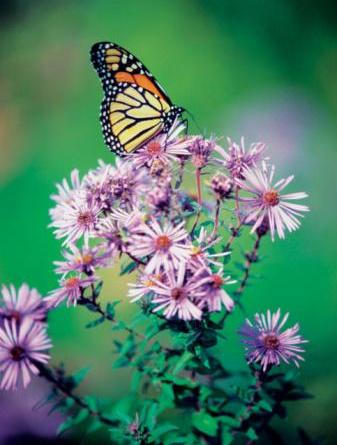Attracting Butterflies
The garden that attracts butterflies is full of surprises because it is constantly changing. With a little bit of planning you can make your landscape irresistible to them while creating a colorful environment that is pleasing to your family as well.
 |
| Butterflies enjoy basking in the sun while feeding. |
Planning Suggestions
It is important to stress that if you are trying to entice butterflies (as well as hummingbirds and other insect eating birds and bats) to your yard, you will need to give up the use of insecticides / pesticides and many herbicides. Most of these products are broad spectrum, and will kill unwanted insect pests as well as those you are trying to attract. Herbicides may kill the host plants that butterflies use to lay their eggs. That does not mean that you have to let the unwanted insects take over. There are many ways of controlling unwanted insects such as Natural Guard Lawn Shield Insect Repellent or Natural Guard Diatomaceous Earth and biological controls (lady bugs, and praying mantis...that we have at Gertens!) that can be used. The friendly staff at Gertens can help you make your yard an inviting place for butterflies.
Butterflies are attracted to broad, sunlit areas. They enjoy basking in the sun while feeding. The warmth of the sun keeps their body temperature high and allows them to stay active. Simple boulders or flat cut-stone in sunlit areas provide good resting places. A stone wall offers natural shelter from the weather. Butterflies also need shelter from wind and weather which can easily be provided with taller shrubs and trees.
Now it's time to add the plants. Remember, if you have any questions, please don't hesitate to ask a Gertens professional. A progressive garden with plants maturing and setting seeds at different times throughout the season increases your chance of success. Most butterflies are attracted to colors in shades of pink, red purple, yellow, and orange. Arrange your plantings in broad masses rather than a mix of color. Look for flower types with large flat flower heads, or plants with clusters of short tubular flowers. Also, keep in mind that butterflies are not only looking for nectar plants, but host plants on which to lay their eggs.
The following perennials are an easy way to get your butterfly garden started. They are all easy to plant and can be purchased at Gertens. Plant in a pattern of your choice, or stop in for some complimentary 'Landscape Coaching'. Search these plants on plant finder to get specific information.
- Achillea 'Desert Eve Red Improved'
- Allium 'Summer Beauty'
- Aster 'Wood's Blue'
- Geranium 'Orion'
- Hererocallis 'Stella De Oro'
- Liatris 'Kobold'
- Monarda 'Bubblegum Blast'
- Nepeta 'Walker's Low'
- Phlox 'David'
- Rudbeckia 'Goldsturm'
- Salvia 'East Friesland'
- Sedum 'Autumn Joy'
More Plants to add to your Butterfly Garden
Annuals
- Ageratum
- Antirrhinum majus (Snapdragon)
- Aster
- Coreopsis
- Dahlia
- Delphinium (Larkspur)
- Gomphrena (Globe Amaranth)
- Impatiens
- Ipomoea (Morning Glory)
- Papaver (Poppy)
- Tagetes (Marigold)
- Tropaeolum (Nasturtium)
- Verbena
- Violas(Pansy)
- Zinnias
Perennials
- Achillea (Yarrow)
- Allium (Ornamental Onion)
- Asclepias (Butterfly Flower)
- Aster (Hardy Aster – good larval host; fall flower)
- Astilbe (False Spirea)
- Bergenia (Pigsqueak)
- Buddleia (Butterfly Bush)
- Coreopsis (Tickseed)
- Delphinium (Larkspur)
- Dianthus (Pinks - Sweet William)
- Echinacea (Coneflower)
- Eupatorium (Joe Pye Weed)
- Leucanthemum (Shasta Daisy)
- Liatris (Gayfeather/Blazing Star)
- Lupinus (Lupine)
- Monarda (Bee Balm)
- Origanum (Ornamental Oregano – late summer, early fall)
- Papaver (Iceland or Oriental Poppy)
- Phlox (Garden Phlox)
- Rudbeckia (Black-eyed Susan)
- Scabiosa (Pincushion Flower)
- Sedum
Shrubs
- Clethra alnifolia (Summersweet) - 'Ruby Spice'
- Forsythia
- Fothergilla
- Rhododendron
- Spiraea (Spirea)
- Syringa (Lilac)
- Viburnum
- Weigela
Trees
- Amelanchier (Chokeberry)
- Catalpa
- Cercis (Redbud)
- Cornus (Dogwood)
- Crataegus (Hawthorn)
- Malas (Crabapple)
- Prunus (Cherry or Plum )
- Salix ( Willow )
- Sorbus (Mountain Ash)
- Tilia ( Linden )
Common Butterflies and Their Host Plants
The following is a list of 14 common butterflies and moths and some of their larval plants:
- Monarch Butterfly - Milkweed, Ascelpias
- Mourning Cloak - Willow, Salix; Birch, Poplar; Nettles, Urtica
- Red Admiral - Nettles, Urtica
- Spring Aure - Dogwood; Viburnums; Spirea
- Tiger Swallowtail - Willow; Cherry; Linden; Birch leaves
- Black Swallowtail - Dill; Carrot; Parsley; Queen Anne's Lace
- Painted Lady - Pearly Everlasting Daisy; Hollyhock
- Buckeye - Snapdragon; Plantain; Stonecrop
- White-lined Sphinx - Virginia Creeper; Grape
- Hummingbird Clearwing - Viburnum; Hawthorn; Honeysuckle
- Fritillary - Violets
- Luna Moth - Hickory; Maple; Oak; Birch
- Cecropia Moth - Silver Maple; Maple; Oak; Cherry
- Polyphemus Moth - Oak; Hickory; Elm; Maple
Remember, if you have any questions about planting a butterfly garden, just ask your friendly Gertens professional. We also carry a great selection of books on butterfly gardening.
